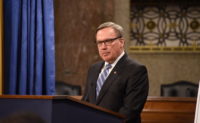When Stephen T. Ayers graduated from the University of Maryland with a degree in architecture in 1985, he joined the military, with dreams of receiving an overseas assignment. But while serving as an officer in the 6510th Civil Engineering Squadron at Edwards Air Force Base in Kern County, Calif., Ayers received orders to move, but to Elmendorf Air Force Base in Anchorage, Alaska—not once, but twice. After the first order, Ayers asked for and received a six-month reprieve before being ordered to Elmendorf again. Rather than report to the chilly Alaskan outpost, Ayers resigned his commission. But he did fulfill his foreign dreams by working for Voice of America, eventually becoming the international broadcaster’s European construction manager. For that post, he was stationed in sunny Greece.
But Ayers, 57, didn’t land what turned out to be his dream job until returning stateside in 1996 to work for the Architect of the Capitol (AOC). Ayers worked his way up to serve as the acting AOC in 2007. Three years later, President Barack Obama nominated Ayers for the permanent post and the Senate confirmed him as the AOC—only the 11th person to hold the position, which was established in 1793. In 2018, Ayers stepped down. “As an architect, and a public architect,” he says, “it just doesn’t get any better than that.” Ayers called serving as the “steward and caretaker” of the Capitol complex “a great opportunity.”
Besides overseeing high-profile projects such as the U.S. Capitol Visitor Center, restoration of the U.S. Capitol Dome and renovation of the Cannon House Office Building, Ayers also worked on the Audio-Visual Conservation at the Library of Congress Packard Campus. Located in Culpeper, Va., the project provides underground storage for the entire audio-visual collection on 90 miles of shelving in a former underground Federal Reserve cash storage and computer operations facility.
Ayers also reduced carbon emissions, increased energy efficiency and implemented sustainable design practices at the Capitol complex. His team also designed and constructed a cogeneration system at the Capitol Power Plant. For these and other accomplishments over his long career, ENR MidAtlantic has named Ayers its Legacy Award winner.
Heading an agency with a $730-million annual budget and 2,300 employees, Ayers oversaw the upkeep and preservation of more than 17.4 million sq ft of facilities and 580 acres of grounds on the Capitol campus. That includes the the U.S. Supreme Court, the Library of Congress, historic House and Senate office buildings, the Capitol itself, the U.S. Botanic Garden and thousands of works of art and trees. Wayne A. Crew, general secretary of the National Academy of Construction, says Ayers’ commitment to developing the AOC staff gave him the ability “to tackle such iconic projects.” Crew adds, “Stephen is the consummate professional who adds value to every organization where he participates.”
Those organizations have been many. Ayers has served as chairman of the Board for the National Institute of Building Sciences, the Construction Users Roundtable and the Construction Management Association of America (CMAA).
In 2018, he was the national conference chair for the National Academy of Construction, where he currently serves on the strategic planning committee. Ayers also was a member of the American Architectural Foundation’s Board of Regents from 2015 to 2017. He recently led a blue ribbon panel for the Smithsonian Institution to review the condition of its facilities and facility-management processes.
Ayers has also won the Construction Industry Institute’s Carroll H. Dunn Award of Excellence and the American Institute of Architects’ Thomas Jefferson Award. In introducing Ayers as the Legacy Award winner at a Nov. 5 lunch in Baltimore, Bruce D’Agostino—retired president and CEO of the CMAA and ENR MidAtlantic’s 2017 Legacy Award winner—said, “Throughout his career, Stephen’s focus has been to advance the architecture, construction and engineering professions for the greater good of the industry and to make a positive impact on the built environment.”
Capitol Security
Although Ayers joined the AOC’s office a year after the 1995 Oklahoma City bombing, he estimated he spent only 5% of his time working on security infrastructure during his first five years on the job. After the Sept. 11, 2001, terrorist attacks, however, Ayers recalls, security-related issues absorbed approximately 30% of his working hours.
Just a week after 9/11, Ayers responded to an emergency at the Hart Senate Office Building where letters containing anthrax spores had been mailed to two Democratic senators.
The letters were among multiple mailings of anthrax in that period after 9/11. In all, five people died—including two workers at a U.S. Postal Service facility in Washington, D.C.—and 17 others were sickened. A few hours after he arrived at the Hart Building, Ayers had his clothes confiscated and was put on medication to counteract potential anthrax exposure.
“As an architect, and a public architect, it just doesn’t get any better than that.”
– Stephen T. Ayers, 11th Architect of the Capitol
Ayers helped move the senators’ offices out of the building overnight and into leased office space, where they stayed for the next seven months while Ayers worked with military experts to remediate the anthrax.
As AOC, Ayers’ duties included serving on the Capitol Police Board, where he spent an “enormous amount of time on security and dignitary protection, physical security, policing, operations and intelligence-gathering,” Ayers says. “They don’t teach you that kind of stuff in architecture school, but it’s so important.”
Ayers helped design security measures that maintained the Capitol’s iconic architecture. “There’s not a fence around the Capitol today because people like me and others try to find alternative solutions,” he says.
Ayers declined to elaborate on specific alternative-security measures, but he says he helped design perimeters of undercover and uniformed police officers. He also helped design and construct the Capitol Visitors Center so that almost everyone who enters the Capitol complex does so from a point about a football field away from the building itself.
Ayers says performing under pressure during and after the Sept. 11 attacks helped prepare him for the top job in his agency, bearing responsibility for some of the most iconic buildings in the world. But he says nothing could have fully prepared him for the “gravity” of testifying before Congress. “I invested an enormous amount of time preparing myself, getting ready to do that, and practicing and executing it,” Ayers says.
Effectively communicating with and building relationships with members of Congress “is vital to success,” Ayers says. That’s no surprise, because one of the AOC’s most important jobs is convincing Congress to fund bread-and-butter operational maintenance work needed to “stave off major renovations” at the Capitol, he says.
Ayers says the key to working in a political environment is to work and communicate in a political style. “You have to be able to sell your programs in a way that they can understand, appreciate and value,” he says. Those were among the best words of wisdom Ayers says he received from his predecessors.
If he gets the opportunity, Ayers says he will impart the same advice to J. Brett Blanton, who was sworn in as the 12th AOC on Jan. 16. Ayers says he’d also like to tell Blanton—the former deputy vice president for engineering at the Metropolitan Washington Airports Authority—to appreciate the AOC staff. “Value them and what they bring to the table and treat them with respect and they in turn will do a great job for you,” he says.
Sustainable Future
Among Ayers’ proudest accomplishments is achieving congressionally set energy-efficiency goals. Those 2007 requirements called on the AOC to reduce its energy consumption by 30% over eight years. That was a daunting task because the AOC-maintained buildings are used around the clock and weren’t designed to accommodate modern technologies.
Ayers and his team met the goal in part by implementing energy data and advanced control systems to improve efficiency. Ayres and his team also improved the ability to generate and deliver chilled water and steam in the Capitol Power Plant. Serving the Capitol since 1910, the facility, which was transitioning to natural gas, was the only coal-burning power plant in the District of Columbia before Ayers’ team converted it to rely mostly on natural gas in 2009. Coal remains a backup energy source.
But, more significantly, the AOC reduced the need to burn coal as a backup fuel source when it completed a 7.5-megawatt cogeneration facility in 2018. Using natural gas in a combustion turbine, the system more efficiently generates electricity, chilled water and heat for steam for the 23 facilities on Capitol Hill. According to the AOC’s office, the cogeneration plant reduces greenhouse gas emissions by 6.5% and hazardous air pollutants by 18%. “That’s an incredibly efficient system that saved us a lot of money,” Ayers says.
As the cogen plant neared completion, Ayers considered completing his own tenure as AOC before his 10-year appointment expired. Then, in June 2017, about 15 months shy of his retirement eligibility age of 56, Ayers fell off a ladder while trimming trees in his yard.
He broke both legs and ankles and shattered a heel. Bedridden for several weeks after surgery, Ayers eventually used a wheelchair and didn’t walk without crutches or a cane until about October 2017. He says while the accident “played into his decision” to ultimately step down as AOC in November 2018, it also “put life into perspective for me” to find ways to “lead a more meaningful life and be more engaged with my family.”
Despite needing another operation, Ayers recently took up mountain biking and is an avid golfer. “I’ve got a great excuse now for all of my golf buddies that I broke both legs, ‘What’s your excuse?’” he says.
As a “semiretired” consultant, Ayers now serves on MOCA Systems’ board of directors, working on strategic growth of the firm’s services and software products division. He also is a member of the National Academies of Engineering’s Board of Infrastructure and Constructed Environment (BICE).
In addition, Ayers is a consultant and project executive for the American Institute of Architects. He is leading AIA through the study, design and renovation of its headquarters building in Washington, D.C. Bill Bonstra of Bonstra | Haresign Architects calls Ayers an “ideal adviser” to the AIA headquarters project “as his experience embodies all aspects of the AIA’s challenging efforts to blend technology, sustainability, preservation, adaptive use of spaces for contemporary needs and exemplary design.”
Ayers says he’ll eventually work less, but he’ll always “have an iron in the fire.”








Post a comment to this article
Report Abusive Comment